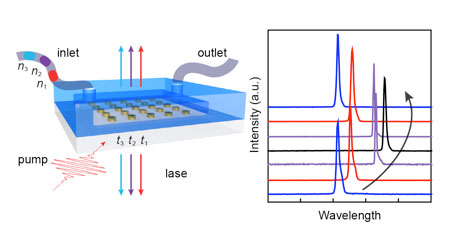| Posted: Apr 21, 2015 | |
Real-time tunable plasmon laser |
|
| (Nanowerk Spotlight) Plasmon lasers are promising nanoscale coherent sources of optical fields because they support ultra-small sizes and show ultra-fast dynamics. They can make possible single-molecule biodetectors, photonic circuits and high-speed optical communication systems. | |
| Plasmon lasers work by coupling electromagnetic waves with the electrons that oscillate at the surface of metals to squeeze light into nanoscale spaces far past its natural diffraction limit of half a wavelength. | |
| Although plasmon lasers have been demonstrated at different spectral ranges, from the ultraviolet to near-infrared, a systematic approach to manipulate the lasing emission wavelength in real time has not been possible. | |
| "The main limitation is that only solid gain materials have been used in previous work on plasmon nanolasers; hence, fixed wavelengths were shown because solid materials cannot easily be modified," Teri W. Odom, Board of Lady Managers of the Columbian Exposition Professor of Chemistry and Professor of Materials Science and Engineering at Northwestern University, explains to Nanowerk. "In our recent work, we have found a way to integrate liquid gain materials with gold nanoparticle arrays to achieve nanoscale plasmon lasing that can be tuned dynamical, reversibly, and in real time." | |
| In a new paper (Nature Communications ("Real-time tunable lasing from plasmonic nanocavity arrays"), Odom' team, together with collaborators from the Schatz Group, designed and realized a plasmon nanolaser whose emission properties can be modulated in real time. | |
 |
|
| Real-time tunable lasing from gold nanoparticle arrays and liquid gain materials integrated in a microfluidic channel. (Image: Odom Group, Northwestern University) | |
| Most plasmon-based nanolasers rely on a solid active laser medium (also called gain material) – such as inorganic semiconducting nanowire or organic dye in a solid matrix –that preclude the possibility of dynamic tuning. | |
| By integrating gold nanoparticle arrays within microfluidic channels and flowing in liquid gain materials with different refractive indices, the researchers were able to dynamically tune the lattice plasmon resonance. | |
| The liquid gain was created by dissolving the dye in different organic solvents in order to index-match the superstrate with the substrate, and which enabled the lasing signal to be tuned over the entire dye bandwidth. | |
| The tuning – in the team's experiment it was over a 55-nm wavelength range – can simply be done by changing the dielectric environment in the microfluidic device. | |
| Odom notes that the use of liquid gain materials has two significant benefits: | |
|
|
|
| According to the team, these nanoscale lasers can be mass-produced with emission wavelengths over the entire gain bandwidth of the dye. | |
| Thus, the same fixed nanocavity structure –the same gold nanoparticle array – can exhibit lasing wavelengths that can be tuned from 860-910 nm, simply by changing the solvent the dye is dissolved in. | |
| "Dynamic control of the far-field lasing emission and the nano-localized lasing fields offer prospects for enhancing light-matter interactions on the nanoscale for real-time monitoring and detection," concludes Odom. "Our system offers a diverse range of possibilities for both ultra-narrow lattice plasmons and ultrasensitive sensing applications as well as for tunable nano-lasers that can be integrated in lab-on-a-chip devices." | |
 By
Michael
Berger
– Michael is author of three books by the Royal Society of Chemistry:
Nano-Society: Pushing the Boundaries of Technology,
Nanotechnology: The Future is Tiny, and
Nanoengineering: The Skills and Tools Making Technology Invisible
Copyright ©
Nanowerk LLC
By
Michael
Berger
– Michael is author of three books by the Royal Society of Chemistry:
Nano-Society: Pushing the Boundaries of Technology,
Nanotechnology: The Future is Tiny, and
Nanoengineering: The Skills and Tools Making Technology Invisible
Copyright ©
Nanowerk LLC
|
|
|
Become a Spotlight guest author! Join our large and growing group of guest contributors. Have you just published a scientific paper or have other exciting developments to share with the nanotechnology community? Here is how to publish on nanowerk.com. |
|
